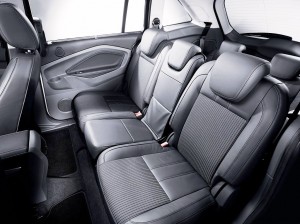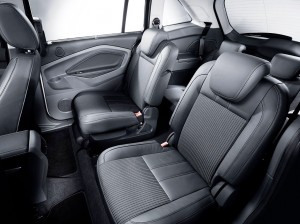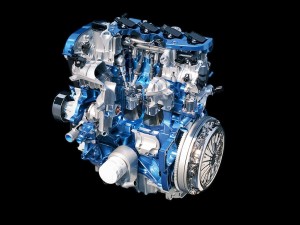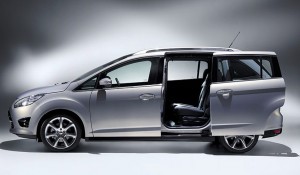The Ford C-Max compact crossover that debuted at the Frankfurt Motor Show this year is notable not only for the addition of a seven-passenger version to the freshened five-passenger model, but it will be the first of gen 2.5 compact C-cars that will belatedly find their way into North American markets.
The new Grand C-Max provides seven passenger seating in a relatively small compact package. There are sliding rear doors on both sides of the van. And anyone who has ever wrestled with getting a child into a child seat will love this; and even if you don’t have younger children – this Chrysler minivan inspired touch – makes loading so much easier.
Better still, to maximize the versatility of the 7-seat layout, engineers have developed a new seat folding mechanism for the three second-row seats. It allows the center seat to fold under one of the two outboard seats, creating an aisle between them – especially nice when the outer seats are occupied by child seats or booster cushions. Owners, therefore, have the option of using the convenient 2+2+2 seating layout, or switching to seven-seats if need be.
C-Max will join the new Fiesta, the Transit Connect commercial van and the next-generation Ford Focus in late 2011 as one of six European-designed models promised by the company under its “One Ford” strategy. This roll-out will take a several years to complete.
This long overdue globalization – going all the way back to the failed Ford 2000 reorganization in the 1990s that didn’t deliver the promised common architectures and powertrains – is the recognition by American executives that their strategy, doggedly pursued under various Revitalization Plans of the past decade, actually resulted in record losses in 2008, as customers defected from the large trucks and SUVs that were at its core.
The new C-MAX models previewed at Frankfurt were in pre-production form prior to their European sales launch in late 2010, which means the U.S. version won’t arrive until about a year later.
Japanese makers, notably Toyota and Honda, have rewritten the gradual roll-out practices of the auto industry by offering simultaneous or rapid launches across global markets in less than 12 months.
Timing aside, the revised C-Max introduces a number of advanced new technologies to the compact van class (multi activity vehicle or MAV in marketing jargon) that the company says are for “enhanced comfort, safety and sustainability,” including the availability of new fuel-efficient low-CO2 Ford “EcoBoost” gasoline engines.
The “all-new” 1.6-liter “EcoBoost” direct-injection gasoline engine is an efficient, albeit expensive engine, so Ford is finally catching up to the latest technology in what seems to be Ford’s perennial powertrain catch-up game.
First, it lags in diesels; fixes them.
Then, it misses the technology changes in gasoline engines and has to chase the competition there.
Then transmissions are missing additional gears that others are offering. (See a pattern?)
Though almost a decade late and initially without a competitive diesel engine, the original C-Max plugged a gaping hole in Ford’s European lineup Along with the second generation Focus and the revised Fiesta from Mazda, Ford finally stopped losing market share in Europe where it is now number two behind Volkswagen.
So here comes “Gen Two” C-Max using the bolder, more rounded, more expressive styling that has appeared recently, which is a complete reversal of the J Mays plains “Braun Coffee maker” design of the first generation of Ford’s “European Turn Around” products.
No real surprises here – good or bad – since C-Max takes its design cues from the iosis Max (sic) concept car unveiled at this year’s Geneva Motor Show. Rounded, sculpted and with a higher beltline, C-Max will fit right in with the latest Fiesta or Focus models now in the showroom.




